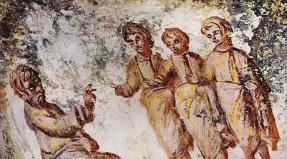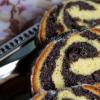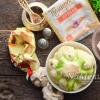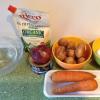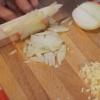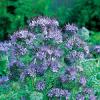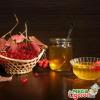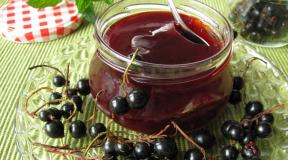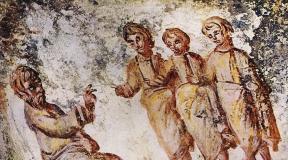Sweet clover is a honey plant. Yellow clover (medicinal). Sweet clover - Seed maturation phase
SEEDS OF HONEY-BEARING PLANTS.
(based on materials from the Beekeeping Research Institute)
Motherwort pentaloba (medicinal)
Motherwort is a perennial plant. Blooms in the second year after sowing. Honey productivity is 200-300 kg/ha.
Motherwort is a good honey plant, has a long flowering period, and is well visited by bees.
Before sowing, it is necessary to disinfect the seeds, which is carried out in two solutions. In a container, dissolve 1 g of potassium permanganate in 1.5 liters of warm water. Pour the seeds into this solution and rinse with it for 10-15 minutes. Rinse the seeds well with clean water. Then place the seeds in a solution of copper sulfate (2 g per 1 liter of water) for 30 minutes. Drain the solution, dry the seeds until they flow and sow them in the ground.
Cold stratification should increase seed germination and germination rate. You can also sow simply with seeds, without stratification. The difference may or may not be noticeable. Depends on conditions. It is visible on a good agricultural background, but not on a bad one. But washing in solutions of potassium permanganate and copper sulfate is mandatory.
If you decide to stratify, then this is how it is done. Transfer the disinfected seeds into a cotton bag. On the north side of the building, dig a hole in a snowdrift to the surface of the ground. Place the seeds there and keep them until sowing day. The duration of stratification is 30-40 days. Instead of a snowdrift, you can use a refrigerator with a temperature of 0-2 degrees C. Monitor the temperature so that the seeds do not begin to grow.
Cultivation techniques. Motherwort, as a perennial plant, is grown in one place for a number of years. The best way to cultivate soil for motherwort is early deep plowing. The main method of breeding motherwort is by seed. Seeds are sown in the ground before winter and early spring (stratified). The seeding depth for winter sowing is 1-1.5 cm, for spring sowing - up to 2 cm, on structural soils - up to 3 cm. In the first year of sowing, caring for motherwort consists of loosening the row spacing and weeding in the rows. In the spring of the second year and subsequent years, last year's dry stems are removed from the field. Before the plants begin to regrow, the field is harrowed in 1-2 tracks; after regrowth, the row spacing is loosened and the weeds in the rows are weeded. Transitional crops in early spring are fed with nitrogen and phosphorus fertilizers (45 kg/ha a.i.). How to collect and dry medicinal plants: http://www.wildherbs.ru/content/view/125/172/
Phacelia tansyfolia
Phacelia is an annual herbaceous plant, one of the best honey plants.
Bees visit the phacelia throughout the day to collect nectar and pollen.
Phacelia honey is almost colorless or light greenish, after crystallization it is white, with a delicate taste and light aroma. Honey in honeycombs does not crystallize, therefore it is suitable for wintering bees. 
 |
Phacelia has little demands on soil fertility and moisture, is cold-resistant, and can withstand frosts down to minus 7-9 degrees. Seeds germinate in the dark. Sowing is carried out from late April to early July, to a depth of 0.5-1.5 cm. Due to the fact that light inhibits seed germination, it is necessary to ensure that the seeds are completely covered with soil. Seeds germinate on 12 - 17 days. From the beginning of germination to flowering it takes about 40 days, flowering lasts 30-35 days. The plant reaches a height of 50-80 cm, has bluish or pinkish-blue flowers of 40-70 pieces in an inflorescence. Honey productivity, according to various literature data, is 300-800 kg per hectare.
Yellow clover (medicinal)
Yellow clover is a herbaceous biennial plant 1-2 m high, an excellent honey plant. The leaves are trifoliate with rounded or lance-shaped leaves, the flowers are small, yellow in color, collected in long racemes (up to 80 flowers in one inflorescence). Flowering of sweet clover occurs in the second year and lasts from June to September. 
 |
The honey productivity of sweet clover is 300 kg/ha or more. Sweet clover honey has excellent taste and medicinal qualities. Another remarkable property of the plant is the lush and very pleasant unique aroma from the above-ground part of the plant. Sweet clover is extremely unpretentious and grows well in poor soils, increasing their fertility and improving their structure. Withstands salinity, winter-hardy, drought-resistant. Sowing of sweet clover is carried out in late April - early May. Sweet clover seeds are sown in the soil to a depth of 2-3 cm.
White clover

White sweet clover is a herbaceous biennial plant similar to yellow sweet clover. It blooms 5-7 days later than yellow sweet clover. Honey productivity up to 500 kg per 1 ha. The flowers are white. Honey is of the highest quality with a pleasant aroma and is white or cream in color. White clover is a component of biological farming. The amount of biologically synthesized nitrogen in the above-ground and underground parts of the plant is 400 kg/ha.
Bruise

 |
Common bruise is a biennial plant. In the first year it forms a rosette of leaves tightly pressed to the ground. In the second year, it forms five to seven flower stems up to 90-150 cm high.
Blueberry is a first-class honey plant, has a long flowering period, and is well visited by bees.
Honey productivity is up to 800 kg/ha.
The flowers of the bruise spica inflorescence have a beautiful blue color. Honey from the bruise is of high quality, crystallizes into a light, fine-grained mass.
Sowing of the bruise is carried out in April-May. The seeding rate is 5-6 kg per 1 ha to a depth of no more than 2-3 cm. After sowing, the area is rolled.
The bruise is not picky about the type of soil; it reproduces by self-sowing. Thus, a bruise once sown produces honey for several years.
Buckwheat
Buckwheat is the most important cereal and honey crop.
The stem is up to 1 m high and forms 8-10 lateral branches.
Up to 1500 flowers are formed on one plant, each of which blooms for 1 day. Flowering lasts 30-40 days.
Honey productivity is 70-90 kg/ha. Buckwheat honey is one of the best varieties of Russian honey.
The color of honey is from dark yellow to dark brown, it has a sharp taste and a pleasant aroma.
Mustard

White mustard is an annual plant with a deep root system and a height of 30-80 cm.
Mustard inflorescence is racemose, multi-flowered. The flowers are lemon yellow with a strong honey scent.
Mustard does not require heat. Seeds begin to germinate at 1-2 degrees. The seedlings can withstand frost.
Mustard blooms 30-35 days after sowing. It is drought resistant. Grows well in poor soils.
Honey productivity 300 kg/ha.
Continuing the topic of honey plants, I cannot help but talk about such a wonderful honey-bearing crop as sweet clover. In a previous article on this topic, I raved about phacelia, an annual honey plant native to California. The seeds of white clover, which I purchased on occasion in one of the stores, lay for a long time, waiting in the wings. And now that time has come. Last fall, a small field became free from under the phacelia. It had been carefully plowed and was eagerly awaiting the sowing of its black flesh with fragrant sweet clover seeds.
Unlike phacelia, sweet clover is a biennial plant and blooms en masse only in the second year. Sweet clover is sown in spring at the rate of 200 grams of seeds per hundred square meters. The seeds are planted to a depth of 1-2 cm. Sweet clover is a winter-hardy plant and can be safely sown before winter, but I did this at the end of April. In the first season, the shoots of sweet clover are low and barely rise above the waist. But in the second year, the sweet clover grows to its full strength. And getting lost in its fragrant thickets costs nothing even for a tall person.
The Latin name for sweet clover is melilotus- honey plant. There are yellow and white sweet clover. Sweet clover belongs to the legume family. It is undemanding to soil and is an excellent green manure. In the first year it is not mowed, and in the second year it is usually mowed twice. After the first mowing, the sweet clover bushes and blooms even more. The aroma of blooming sweet clover cannot be confused with anything else. It blooms for a long period, even in the dry season.
This is what the field looked like in the second year, which I sowed with white clover (on the left).
If you are suddenly lucky and not far from your apiary a large collective farm field is sown with sweet clover, or you arrive at such a field with a migration, then do not rush to rejoice. The fact is that in most cases, sweet clover is harvested for silage during the period of its mass flowering (as is sometimes the case with sunflower). At the same time, countless bees located in the honey collection, along with the mowed green mass, fall into the chopper of the silage combine and die. The beekeeper suffers irreparable damage. Notifying the beekeeper about the upcoming mowing is very important here. Devices that repel bees are rarely used. Of course, you can mow into windrows at night and harvest for haylage during the day, but crop owners often have their own ideas.
Finally, some useful tips that I tested on myself for those who want to cultivate sweet clover in their own area. In the second year after the end of flowering of the sweet clover, do not rush to mow it or pull it out of the ground. Collect the seeds and leave them to overwinter in the field. Over the winter, its long root system will rot and in the spring you can easily pull the sweet clover bushes out of the soil. Many people think that it is enough to sow a field with sweet clover once and it will grow in this field forever. Nothing like this. After two years, the field becomes overgrown with grass and requires re-cultivation. Likewise, there is no point in throwing sweet clover seeds into the grass, hoping that they will germinate. Sweet clover, although an unpretentious plant, still needs field preparation.
Depending on the soil and climatic conditions, the honey productivity of sweet clover is from 100 to 600 kg/ha. Sweet clover is an excellent honey plant and produces nectar well even in drought. Its honey is of very high quality, medicinal and contains about 60 medicinal components. Sweet clover honey is one of the expensive elite varieties. Due to its high glucose content (36.78%) it is white in color. White sweet clover honey has a strong vanilla aroma. Yellow sweet clover honey has a more subtle and delicate aroma. In folk medicine, sweet clover honey is successfully used in the treatment of:
- diseases of the upper respiratory tract (bronchitis, tonsillitis, etc.);
- headaches and insomnia;
- hypertension, and especially good for heart disease;
- purulent wounds and boils are well treated with external compresses based on a combination of sweet clover honey and propolis;
- for inflammation of the mammary glands and joints, honey massage brings success;
- for myositis, take warm baths with sweet clover honey;
Sweet clover honey is highly valued in the USA. There, its share in total sales reaches 70%.
White clover - description of the plant, agricultural technology, honey productivity, seeding rates
White clover / Melilotus albus Medik.
Description: White sweet clover is a biennial plant. The stem is erect, up to 2 m high. The leaves are trifoliate, the leaflets are lanceolate, serrated along the edge. The flowers are white, collected in racemose inflorescences 10-16 cm long. The root is a taproot up to 2 m deep into the soil. The fruit is an ovoid pod 3-3.5 mm long. The seeds are small, yellow-green or yellow, remain viable for up to 10 years or more.
Honey productivity: from 160 to 600 kg/ha. On average 500 kg/ha, up to 400 kg/ha in Buryatia, 170 kg/ha for the Kemerovo region. Sweet clover honey is white or cream-colored, of the highest quality with a pleasant aroma.
Honey composition: Fructose: 67.48-82.84% (for Bashkiria)
Flowering time: Flowering begins in the last ten days of June and until the beginning of September (in Bashkiria). Flowering duration is up to 50 days, in some cases it blooms until late autumn.
Biological features: In the first year of life, it lays two or three buds on the root collar at a depth of 0.5-10 cm from the surface. In the second year it grows from renewal buds; after the seeds ripen, its development cycle is completed. In the first year it is easily drowned out by weeds. Sweet clover is a light-loving plant; in the first year of life it does not tolerate shading. Germinates at a temperature of +2..+3C. Frost- and winter-hardy, tolerates frosts down to -5C in spring. In the first year of life it is sensitive to drought, in the second it is drought-resistant due to its powerful root system. Sweet clover is not picky about soil; it can grow on chernozems, loamy, podzolic, carbonate, saline, and sandy soils. Negatively relates to acidic soil.
Agricultural technology: The optimal placement of sweet clover seeds is 0.5-2.5 cm (on heavy soils they are not planted deeply, on light soils - deeper), it is very important to avoid drying out the soil. Sweet clover seeds are covered with a hard shell, so they need scarification (apply scratches so that the seeds begin to swell). Scarification at home can be done with sandpaper manually, or in a concrete mixer with sandpaper glued to the walls. Seed germination will reach 90% after treatment. 10-15 days before sowing, the seeds are brought into a warm room, dried and heated. Sweet clover can be introduced into any crop rotation. It is sown with winter rye, spring wheat, and not preferably with oats and barley, which inhibit it. Good results are obtained by sowing sweet clover in a 30 cm wide row spacing next to oats. Overseeding with millet gives good results. Sweet clover produces more vigorous shoots when sown in late autumn. But it is impossible for sweet clover to germinate before winter. In spring you need to sow early, because... seeds require moisture. Seeding rates are 14-20 kg per hectare for row sowing and 6-8 kg/ha for wide-row sowing. When mowing sweet clover in the first year of life, 20-22 cm of stubble is left, this is optimal for the subsequent development of the plant.
Seeding rates: 12-16 kg/ha, 0.12-0.16 kg/100m2, 1.2-1.6 g/m2
Compound: White sweet clover contains coumarin, an aromatic substance.
Medicinal properties: Coumarin is an aromatic substance that has an antiseptic, antihelminthic effect and induces appetite. The decoction can be used to combat bee varrosis
Note: The depth of the roots of sweet clover is up to 2 m - this is a valuable green manure that is unpretentious to the soil and synthesizes a large amount of nitrogen (400 kg/ha). Sweet clover is a valuable fodder plant, contains a large amount of protein, increases the milk yield of cows, and improves the quality of butter and cheese. White clover seeds can be purchased at many seed stores.
Yellow sweet clover has an amazing coumarin smell. This biennial plant belongs to the Sometimes plants exceed 2 m in height. The stem is branched, slightly pubescent, straight. The flowers are small, yellow, moth-like, located on short stalks. They are collected in axillary brushes. Each cluster has up to 70 drooping flowers. Yellow sweet clover blooms from early summer to September, and the seeds ripen until late autumn. The plant reproduces by seeds. It is found almost everywhere. It grows along the edges, along roads, in ravines, in bushes, and dry meadows. Prefers fresh and dry soils.
The generic name of this plant comes from a Greek name meaning “honey clover.” It always attracts huge numbers of honey bees. The sugar content in yellow sweet clover nectar exceeds the same indicator by 1.5-2 times. Some beekeepers, in order to obtain sweet clover honey in large quantities, mow down the plant during the period of mass flowering, thereby extending its duration.
The entire herbaceous part of the plant is considered a medicinal raw material. It is collected during the period of mass flowering, cutting off the side shoots and tops. When preparing raw materials, you should not cut off coarse and thick stems. You can't collect it along roads. Raw materials must be harvested after the dew has disappeared in dry weather. When picked wet, it warms and darkens. The collected grass is immediately sent for drying.
The herb, information about which is quite complete, unfortunately, is rarely in demand among consumers, since few people know about its beneficial properties. The biological activity of this plant is due to the presence of coumarin. This substance can increase systolic blood pressure, can increase heart volume and the number of leukocytes, improve peripheral and blood supply, as well as blood circulation in the abdominal cavity.
In folk medicine, yellow clover was used for flatulence as a hemostatic and emollient. There is information about the use of this plant for the treatment of epidemic encephalitis. This herb is used as a laxative. It is included in various softening fees. Decoctions and infusions of sweet clover are used for flatulence, respiratory diseases, atherosclerosis, and hypertension. It is often used as an expectorant, diuretic, antibacterial, antispasmodic, sedative, hypotensive, and analgesic.
An excellent result is obtained by using sweet clover as an external remedy for furunculosis, abscesses, mastitis, malignant tumors, and rheumatism of the joints. For external use, decoctions and infusions of this herb are used. Usually they are used for compresses, baths, washes, lotions, poultices, and plasters.
Although sweet clover is an excellent medicinal plant, it has many contraindications. It should not be given to pregnant women or those with bleeding. Like any medicine, yellow clover requires careful dosage.
Side effects may also occur when taking this herb. Taking the drug in large quantities depresses the nervous system and has a negative effect on smooth muscles. Long-term use of sweet clover and its overdose cause headaches, dizziness, nausea, vomiting, liver damage, drowsiness, hemorrhages, and paralysis of the nervous system.
The medicinal use of sweet clover can be carried out only after consultation with a doctor and under his direct supervision.
White sweet clover Melilotus albus Medik is a biennial, less often annual, herbaceous plant of the legume family with an erect, branched, well-leafed stem. The leaves are trifoliate, with jagged edges, alternate. The flowers are small, drooping, moth-type, on short pedicels, collected in narrow elongated lush (from 40 to 80 flowers) racemes. Nectar-bearing tissue is located at the base of the corolla around the ovary. Mass flowering of sweet clover occurs at the beginning of July and lasts almost until autumn. The nectar of one flower contains from 0.08 to 0.15 mg of sugars. Honey productivity per hectare is 100–500 kg. Honey is light, with a delicate aroma, pleasant taste, crystallizes into a white fine-grained mass, contains 37% glucose and 40% fructose.
White sweet clover is a valuable promising plant that provides bees with nectar and pollen. In addition, it plays an important role in creating a strong forage base for livestock farming, recultivating infertile lands, and also in the fight against soil erosion.
Sweet clover is unpretentious to soils and can grow on rocky and loamy soil, in fields, pastures, wasty places, in ravines, hills, in steppes, along roads, railway embankments. It is a cross-pollinated plant, but self-pollination is also possible.
The purpose of the study is to determine the honey productivity of white sweet clover in the conditions of the Kostroma region and to study the dependence of sugar productivity on abiotic factors (temperature, air humidity, time of day).
To determine the sugar content in white sweet clover flowers, samples were taken from 9 to 21 hours. To calculate honey productivity, plots were laid out on which the number of plants and inflorescences per plant was counted, its height was measured, and the projective cover was determined. The duration of flowering of sweet clover flowers was determined by the method of phenological observations.
 Statistical data obtained for white sweet clover at trial sites are presented in the table.
Statistical data obtained for white sweet clover at trial sites are presented in the table.
Based on the results of the given data, the number of inflorescences and flowers per hectare was calculated with 100% projective coverage, which amounted to 3789 and 231,122 pieces. respectively.
Since the flowering time of one flower is two days, the honey productivity of white sweet clover during the flowering period will be 462 kg/ha.
 Nectar production by plant flowers depends on many factors, including temperature, humidity and time of day. It should be noted that warm weather has a beneficial effect on nectar release only if there is sufficient air humidity. The optimal temperature for nectar release for most honey plants is considered to be 16–25°C and air humidity 60–80%. The nectar productivity of many plants varies during the day. In most plant species, nectar is secreted more intensely around 9 a.m., then its secretion weakens. In some species, nectar production increases during the midday or evening hours.
Nectar production by plant flowers depends on many factors, including temperature, humidity and time of day. It should be noted that warm weather has a beneficial effect on nectar release only if there is sufficient air humidity. The optimal temperature for nectar release for most honey plants is considered to be 16–25°C and air humidity 60–80%. The nectar productivity of many plants varies during the day. In most plant species, nectar is secreted more intensely around 9 a.m., then its secretion weakens. In some species, nectar production increases during the midday or evening hours.
The dynamics of sugar production by white sweet clover flowers depending on abiotic factors is shown in the figure.
Analysis of variance of the data obtained during the experiment allows us to note that the share of the influence of air temperature on the production of sugars by white sweet clover flowers during the observation period was 40%, air humidity - 30%, time of day - 31%.
Thus, in the conditions of the Kostroma region, the honey productivity of one white sweet clover flower during the flowering period at an average temperature of 28 ° C and air humidity of 56% was 0.2 mg, one plant - 268.4 mg, one hectare of continuous thickets - 462 kg. The variability of the honey productivity trait of sweet clover is determined by air temperature, time of day and air humidity.
L.V.SUKHANOVA,
Candidate of Biological Sciences
Mari State Technical University
Annotation:
Experimental data on the honey productivity of white sweet clover in the Kostroma region and the dynamics of sugar productivity depending on abiotic factors are presented.
Keywords:
white sweet clover, sugar productivity, honey productivity, abiotic factors.
LITERATURE:
1. Beekeeping. - M.: Sov. encyclopedia, 1991.
2. Cherevko Yu.A., Boytsenyuk L.I., Vereshchaka I.Yu. Beekeeping - M.: Koloss, 2008.
3. Sukhanova L.V. Ivan-tea angustifolia // Beekeeping. - 2010. - No. 8.
4. Cherevko Yu.A. Homestead farming. Beekeeping. - M.: EKSMO Press, 2001.
5. Klimenkova E.T., Kushnir L.G., Bachilo A.I. Honey plants and honey collection - Minsk: Urajai, 1980.
6. Glukhov M.M. Honey plants. - M.: Kolos, 1974.



